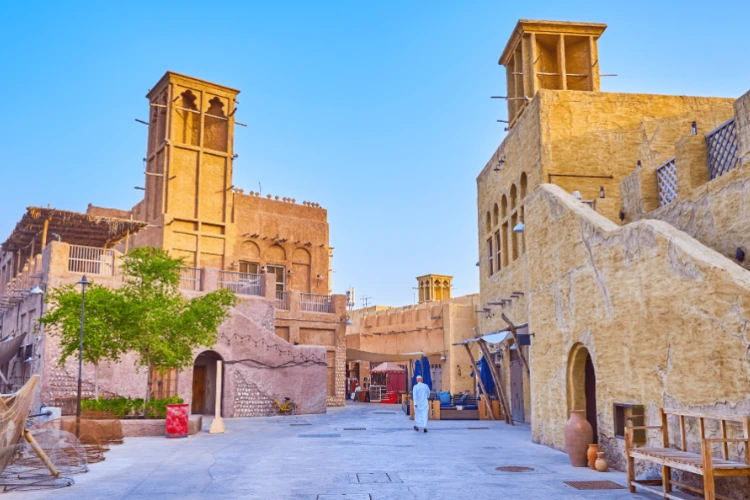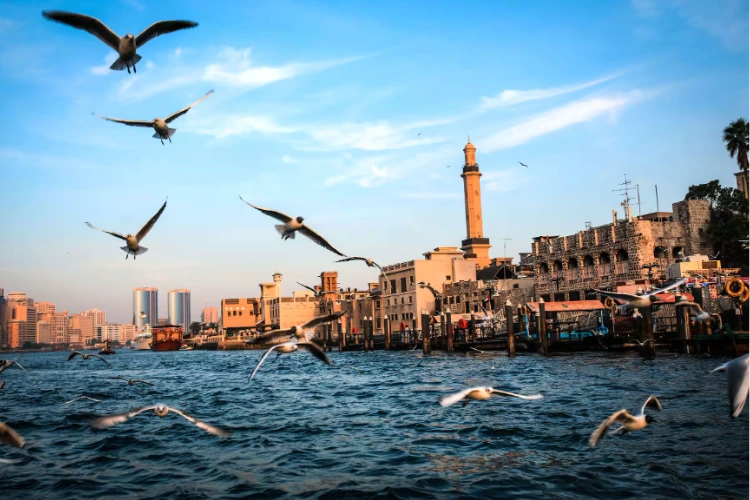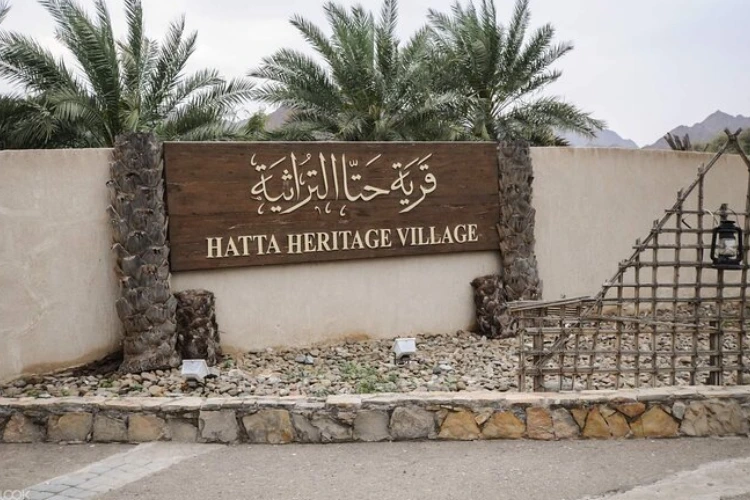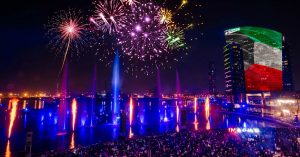When people think of Dubai, they usually picture big skyscrapers and fancy malls. But Dubai has a whole different side filled with history. There are old neighborhoods that show what Dubai was like before it became the city we know today, a small fishing village and busy trading port.
So, if you’re visiting Dubai and want to see more than just the shiny stuff, you’ve got to check out these historic places. Trust me, it’s totally worth it! Want to see where Dubai started? Head over to the Al Fahidi Historical Neighborhood. It’s one of the oldest parts of the city and has been around since the 1800s. Pretty cool, right?
Al Fahidi Historical Neighborhoods (Al Bastakiya)
Al Fahidi is one of Dubai’s oldest neighborhoods, full of charm. The area is known for its traditional wind-tower houses and takes you back to the late 1800s. Originally called Al Bastakiya, it was home to wealthy Persian merchants who came to Dubai for trade. Even today, as you walk through these streets, you can see the mix of old history and modern culture.
A must-see here is the Dubai Museum, which is inside the 1787 Al Fahidi Fort. It gives you a great look at how Dubai changed from a small fishing village into a big city. Also, don’t miss the Sheikh Mohammed Centre for Cultural Understanding and the Coffee Museum. They’re both right in the area and show off the traditions and culture of Dubai. Trust me, a stroll through these peaceful streets will teach you so much about the city’s past!

Al Shindagha Heritage District
Next, let’s head to Al Shindagha, a neighborhood that’s super important in Dubai’s history. It’s right along the Dubai Creek and was once home to the Al Maktoum family. Back in the day, this area was full of life, with lots of trade and commerce happening. You can still see the old Dubai here, especially at the Saeed Al Maktoum House, which is now a museum.
Today, Al Shindagha is a cultural spot with a bunch of exhibitions and heritage sites to check out. The Al Shindagha Museum is a great place to learn about Dubai’s people, traditions, and how the city has developed over time. It’s a cool mix of the past and the present, and walking through here really shows you the heart of Dubai. Can you imagine living somewhere so rich in history and so close to where Dubai really started to change?
Bur Dubai: Where History Meets Modernity
Now, let’s talk about Bur Dubai, one of the most vibrant parts of the city. Bur Dubai is located on the southern side of the creek, and it’s a place that’s full of life. You’ll find the Grand Mosque, which has the tallest minaret in Dubai, along with the Dubai Museum housed in the historic Al Fahidi Fort. This is where Dubai’s transformation really began. Imagine standing in a fort that’s been around since 1787, it’s almost like stepping into a time machine.
But Bur Dubai isn’t all about the past; it’s also a place that blends old-school charm with modern development. There are traditional souks (markets), where you can shop for spices and gold, and plenty of restaurants and cafes that give the neighborhood a modern touch. Walking through Bur Dubai is like experiencing both sides of the city, past and present, right at the same time.

Deira: A Commercial Hub with a Rich History
Deira is another gem when it comes to Dubai’s historical neighborhoods. Located across the creek from Bur Dubai, Deira was once the heart of Dubai’s trade and commerce. Today, it’s still a bustling hub with the famous Gold Souk and Spice Souk. These markets are not just about shopping, they’re also about experiencing the rich trading history of Dubai, where people have gathered for centuries to buy and sell goods.
Deira might be known for its hustle and bustle, but there’s more to it than just being a commercial district. The area’s roots in the city’s early economy are evident, and it offers an authentic Dubai experience, especially in the old market streets. You might even get lost in the maze of souks, but that’s all part of the charm.
Hatta Heritage Village: A Step Back in Time
A little outside the city, in the Hajar Mountains, you’ll find Hatta, a village that shows a different side of Dubai. If you want to see what life was like in rural Dubai, Hatta Heritage Village is the place to go. It’s full of traditional mud-brick houses, watchtowers, and a mosque that’s been around since the 18th century. This village gives you a peaceful look at Dubai’s past.
What makes Hatta stand out is how well it’s been preserved. Walking through the village feels like stepping back in time. And get this, there’s actually archaeological evidence of settlements in the area that date back to the Early Bronze Age! How cool is that?

Al Jaddaf: The Shipbuilding Legacy
Let’s head over to Al Jaddaf now. Ever heard of a “dhow”? These traditional wooden boats are a huge part of Dubai’s maritime history, and Al Jaddaf is where a lot of that history came to life. The name “Al Jaddaf” actually means “The Rower,” and back in the day, this area was the hub for dhow-building. These boats were key to Dubai’s trade and fishing industries. Even now, you can see traditional dhows being built and repaired at the Dubai Ship Docking Yard.
But here’s the thing, Al Jaddaf isn’t just about wooden boats anymore. It’s also home to Dubai Maritime City, a modern district focused on keeping Dubai’s maritime traditions alive while bringing in some fresh, modern ideas. So if you’re into history, ships, or just love being around the water, this place should definitely be on your list. Can you imagine that a spot with such deep roots in Dubai’s past is now helping shape its future in the maritime world?
Hatta: A Quiet Escape to Dubai’s Rural Past
Let’s head back to Hatta, which is about an hour and a half drive from central Dubai. The Hatta Heritage Village is a great reminder that Dubai isn’t all about tall buildings and fancy hotels. When you walk through Hatta, you’re stepping into a quieter, slower pace of life, surrounded by the breathtaking Hajar Mountains. This village is full of traditional stone houses, watchtowers, and the kind of old-school architecture that gives you a real taste of Dubai’s rural past.
Visiting Hatta is like stepping into a time capsule, where you can see how people lived hundreds of years ago, long before the city grew into what it is today. And if you love nature, Hatta is a paradise. It’s perfect for hiking, kayaking, or just soaking in the peaceful outdoor vibe. So, if you’re looking for a break from the busy city, Hatta is the ideal escape.
Why Visit These Neighborhoods?
Now, I know what you’re thinking: why should you go out of your way to visit these neighborhoods? The truth is, Dubai’s charm isn’t just in its towering skyscrapers or flashy malls. It’s in these historical neighborhoods, where the city’s roots are firmly planted. These places give you a chance to step back in time and really understand the cultural and historical foundation that shaped Dubai.
You’ll see how trade, culture, and community were the driving forces behind Dubai’s early growth. And, while you’re there, you might even meet some of the friendly locals who have seen the city change over the decades.
Plus, visiting these areas offers a welcome break from the typical Dubai tourist spots. Instead of shopping malls and resorts, you get to experience something real, something that tells the story of Dubai’s past in a way you won’t find anywhere else.
Conclusion
So, here’s the deal. Dubai’s charm isn’t just in those crazy skyscrapers and shiny malls, it’s in the history you can find in its oldest neighborhoods. I mean, when you take a walk through places like Al Fahidi, Al Shindagha, Bur Dubai, and Deira, you’re not just seeing the city, you’re literally walking through its past. Pretty cool, right?
These spots are like little time machines. From the old wind-tower houses in Al Fahidi to the busy markets in Deira, you get a real sense of how Dubai grew from a small fishing village to the global city we know today. And the best part? You’re not stuck in some tourist trap, you’re soaking in the history, the culture, and the vibe of the real Dubai.
So, what do you think? Next time you’re in Dubai, take a break from the malls and high-rises, and give these historic neighborhoods a visit. You won’t regret it. Trust me.
What is the best time to visit Dubai’s historical neighborhoods?
The best time to visit is during the cooler months, from November to March, when the weather is pleasant and perfect for outdoor exploration.
How do I get to the Al Fahidi Historical Neighborhood?
You can easily reach Al Fahidi by public transport, such as the Dubai Metro (Al Fahidi Station), or by taking a short taxi ride from popular areas like Dubai Mall or Bur Dubai.
Are there guided tours available for Dubai’s historical neighborhoods?
Yes, many tours offer guided experiences of Dubai’s historical neighborhoods, including walking tours, museum visits, and cultural insights.
Is there an entrance fee to visit Dubai Museum and Al Fahidi Fort?
Yes, there is an entrance fee for Dubai Museum, typically around AED 3 for adults and AED 1 for children.
Can I shop for souvenirs in Dubai’s historical neighborhoods?
Definitely! Markets like the Gold Souk in Deira and the traditional souks in Bur Dubai are great places to buy souvenirs like spices, textiles, and jewelry.
How long should I spend exploring the historical neighborhoods of Dubai?
You can spend a half-day to a full day exploring Dubai’s historical neighborhoods, depending on how many sites you want to visit and the depth of your interest in history.





